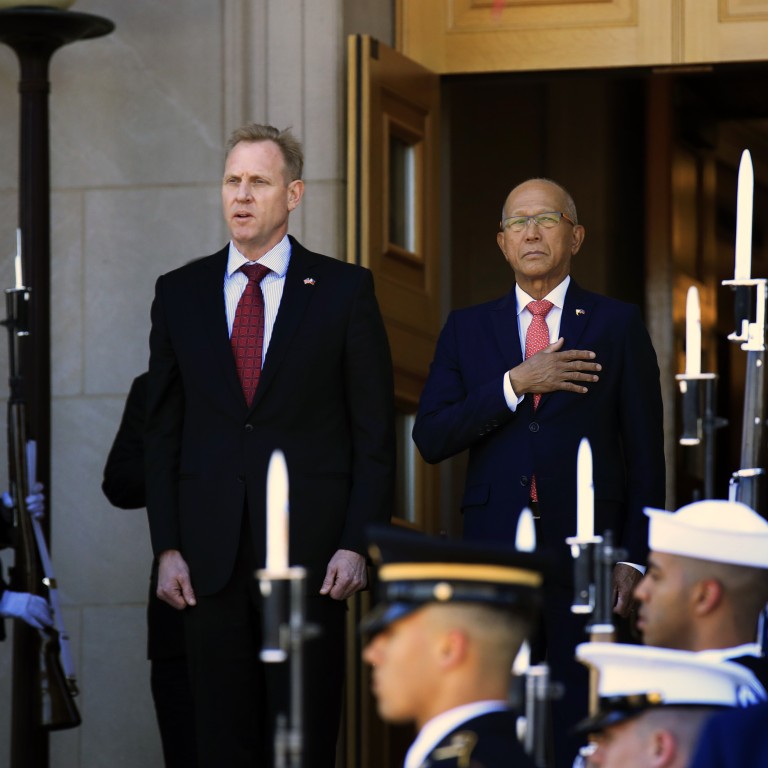
Philippine defence minister Delfin Lorenzana protests over South China Sea ‘encroachment’
- Manila says it has filed a diplomatic complaint over the recent build up of Chinese vessels in the disputed Spratly Islands
- Philippine defence minister uses meeting with US counterpart Patrick Shanahan to express ‘concern’ about the fleet’s activities
The Philippine defence minister has protested against Chinese “encroachment” on the country’s maritime rights after the appearance of a large fleet of vessels in a disputed part of the South China Sea.
Delfin Lorenzana told reporters at a meeting with his US counterpart in Washington on Monday that China’s increased presence in the disputed waterways was “very concerning”.
“They have been building islands from reefs since, I think, 2011 [or] 2012,” Lorenzana said, according to a transcript released by US Department of Defence. “So it concerns us because they are encroaching on our EEZ [exclusive economic zone].”
Thitu island, known as Zhongye in China and Pagasa in the Philippines, is the largest island held by Manila in the waters, which are also claimed by mainland China, Taiwan and Vietnam.

States have special rights regarding the exploration and use of marine resources in their exclusive economic zones – areas of sea that extend up to 200 nautical miles (about 370km) from the coast.
“The mere fact that they are there and just staying there for a week, why, what are they doing there?” Salvador Panelo, a spokesman at the Philippine Department of Foreign Affairs said during a news conference on Monday.
Zhao Jianhua, the Chinese ambassador to the Philippines, told Reuters that the Chinese vessels were fishing boats, adding: “You don’t have to worry about whether there would be any kind of outbreak of conflict or not.”
Zhao said that both Chinese and Filipino fishermen are present in the contested waters and denied media reports that Chinese fishermen were carrying firearms.
Zhao also insisted that Beijing and Manila were handling their maritime dispute through friendly and diplomatic channels.
Thitu is just 12 nautical miles (about 22km) away from Subi Reef, one of the three Chinese man-made islands where anti-ship and surface-to-air missile systems are reported to have been installed.
In Washington, Lorenzana and his American counterpart, acting US defence secretary Patrick Shanahan, reaffirmed the “enduring alliance” between the two countries, despite the Philippines’ populist president Rodrigo Duterte’s pursuit of warmer ties with Beijing since taking office in 2016.
As part of this rapprochement, Duterte’s administration has overlooked a 2016 Hague ruling on the South China Sea dispute, brought by the previous government, in Manila’s favour.
On Monday, the two defence chiefs agreed on the need to increase interoperability between the two militaries through exercises, training, and US support for the modernisation of the Philippine armed forces, according to a Pentagon statement.

During a visit to Manila in early March, US Secretary of State Mike Pompeo promised that the US would defend Manila in the event of a conflict in the South China Sea.
“Any armed attack on Philippine forces, aircraft or public vessels in the South China Sea would trigger mutual defence obligations under Article 4 of our Mutual Defence Treaty,” Pompeo said at a news briefing.
The Philippine defence chief also said that they Chinese were interested in investing in Subic Bay, the former site of a US military base that closed in 1992.
Two Chinese shipbuilding companies are eyeing a large plot of land currently occupied by Hanjin Philippines – a local subsidiary of South Korean shipbuilder Hanjin Heavy Industries and Construction.
Last month, Hanjin Philippines announced that it was pulling out of Subic Bay after declaring bankruptcy.
“They’re waiting in the wings,” Lorenzana said. “But we are also talking to a lot of interested parties in the US, in Japan, Korea, from European countries, and from Singapore and Indonesia.”

